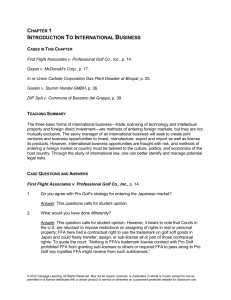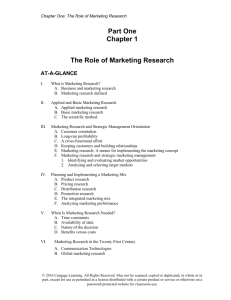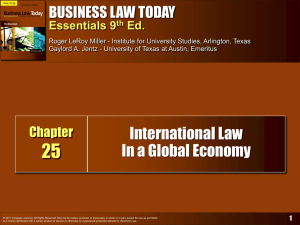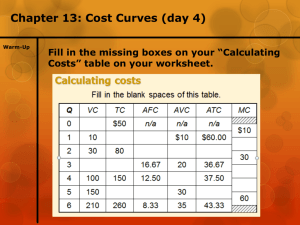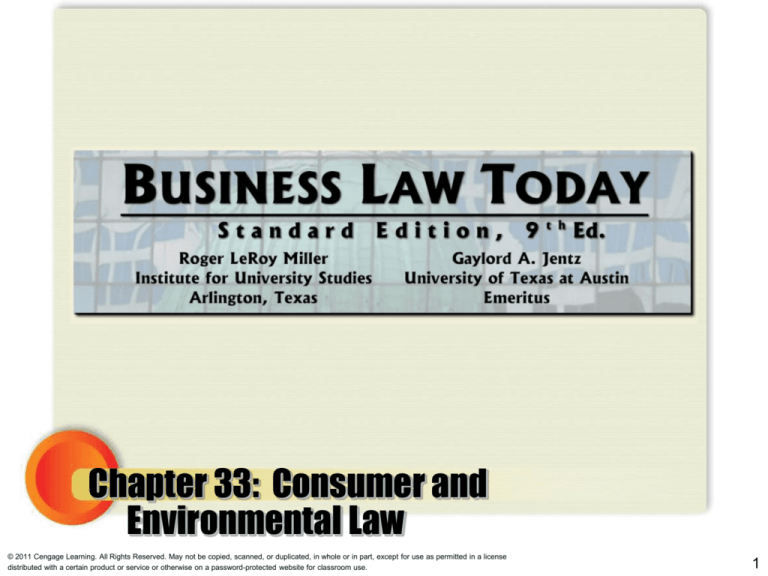
Chapter 33: Consumer and
Environmental Law
© 2011 Cengage Learning. All Rights Reserved. May not be copied, scanned, or duplicated, in whole or in part, except for use as permitted in a license
distributed with a certain product or service or otherwise on a password-protected website for classroom use.
1
Learning Objectives
• When will advertising be deceptive?
• What are the major federal statutes providing
for consumer protection in credit transactions?
• Under what common law theories can polluters
be held liable?
• What is contained in an environmental impact
statement, and who must file one?
• What does the Environmental Protection
Agency do?
• What major federal statutes regulate air and
water pollution? What is Superfund? To what
categories of persons does liability under
Superfund extend?
© 2011 Cengage Learning. All Rights Reserved. May not be copied, scanned, or duplicated, in whole or in part, except for use as permitted in
a license distributed with a certain product or service or otherwise on a password-protected website for classroom use.
2
Learning Objectives
• Under what common law theories can
polluters be held liable?
• What is an environmental impact statement,
and who must file one?
• What does the Environmental Protection
Agency do?
• What major federal statutes regulate air and
water pollution?
• What is Superfund? To what categories of
persons does liability under Superfund
extend?
© 2011 Cengage Learning. All Rights Reserved. May not be copied, scanned, or duplicated, in whole or in part, except for use as permitted in
a license distributed with a certain product or service or otherwise on a password-protected website for classroom use.
3
Consumer Law
© 2011 Cengage Learning. All Rights Reserved. May not be copied, scanned, or duplicated, in whole or in part, except for use as permitted in
a license distributed with a certain product or service or otherwise on a password-protected website for classroom use.
4
Consumer Law
• Areas of Consumer Law Regulated by
Statutes:
– Deceptive Advertising.
– Labeling and Packaging.
– Sales.
– Credit Protections.
– Consumer Health and Safety.
– State Consumer Protection.
© 2011 Cengage Learning. All Rights Reserved. May not be copied, scanned, or duplicated, in whole or in part, except for use as permitted in
a license distributed with a certain product or service or otherwise on a password-protected website for classroom use.
5
Deceptive Advertising
• Puffery.
– Vague generalities and obvious exaggerations
are permissible and not considered deceptive.
Case 33.1 Federal Trade Commission v.
QT, Inc.
Claims of the Ionized Bracelet were deceptive and QT
was ordered to create a $16 million fund for customer
refunds.
• Bait and Switch Ads.
– The advertising of a product at an attractively
low price to lure customers in to buy more
expensive items.
© 2011 Cengage Learning. All Rights Reserved. May not be copied, scanned, or duplicated, in whole or in part, except for use as permitted in
a license distributed with a certain product or service or otherwise on a password-protected website for classroom use.
6
Deceptive Advertising
• Online Deceptive Advertising.
– Same rules apply.
– To satisfy the “clear and conspicuous”
requirement, disclosures must be close (only
hyperlink if lengthy).
© 2011 Cengage Learning. All Rights Reserved. May not be copied, scanned, or duplicated, in whole or in part, except for use as permitted in
a license distributed with a certain product or service or otherwise on a password-protected website for classroom use.
7
FTC Actions Against Deceptive Advertising
• The FTC, charged with enforcing federal
laws against deceptive advertising, can,
in appropriate circumstances:
– Issue cease and desist orders.
• With respect to a particular product or
advertisement.
• With regard to multiple product orders.
– Impose counter-advertising.
© 2011 Cengage Learning. All Rights Reserved. May not be copied, scanned, or duplicated, in whole or in part, except for use as permitted in
a license distributed with a certain product or service or otherwise on a password-protected website for classroom use.
8
Telemarketing and Fax Advertising
• The Telephone Consumer Protection Act
(TCPA) prohibits automated solicitation using
automatic telephone dialing system or a
prerecorded voice.
• Consumers have a private civil cause of
action and can recover $500 for each
violation of actual damages. Court can treble
damages if willful violation.
• Telemarketer must remove a consumer’s
name from its list of potential contacts if
requested.
© 2011 Cengage Learning. All Rights Reserved. May not be copied, scanned, or duplicated, in whole or in part, except for use as permitted in
a license distributed with a certain product or service or otherwise on a password-protected website for classroom use.
9
Labeling and Packaging
• Labeling must be accurate, and
must use words that are easily
understood by the ordinary
consumer.
• Product labeling and packaging
are regulated by:
–
–
–
–
–
Wool Products Labeling Act of 1939.
Fur Products Labeling Act of 1951.
Flammable Fabrics Act of 1953.
Fair Packaging and Labeling Act of 1966.
Smokeless Tobacco Health Education Act of
1986.
– Nutrition Labeling and Education Act of
1990.
© 2011 Cengage Learning. All Rights Reserved. May not be copied, scanned, or duplicated, in whole or in part, except for use as permitted in
a license distributed with a certain product or service or otherwise on a password-protected website for classroom use.
10
Sales
• Forms of Sales :
– Door-to-Door Sales.
– Mail Order Sales.
– Telephone and Mail-Order Sales.
– Unsolicited Receipt of Merchandise.
© 2011 Cengage Learning. All Rights Reserved. May not be copied, scanned, or duplicated, in whole or in part, except for use as permitted in
a license distributed with a certain product or service or otherwise on a password-protected website for classroom use.
11
Door-to-Door Sales
• Most states requires that, for door-todoor sales, consumers have a post-sale
“cooling-off” period during which they
can cancel their purchase without
obligation.
• Consumers are given the most
favorable benefits of the FTC rule and
their own state statutes.
© 2011 Cengage Learning. All Rights Reserved. May not be copied, scanned, or duplicated, in whole or in part, except for use as permitted in
a license distributed with a certain product or service or otherwise on a password-protected website for classroom use.
12
Telephone and Mail Order Sales
• Sellers can be subject to federal mail and wire
fraud statutes.
• FTC Rules require:
– shipment orders within the time promised in their
catalogues and advertisements,
– to notify consumers when orders cannot be shipped on
time, and
– to issue timely refunds when orders cannot be shipped.
• The Postal Reorganization Act of 1970 provides
that unsolicited merchandise sent by U.S. mail
may be retained, used, discarded, or disposed
of in any manner deemed appropriate, without
the recipient’s incurring any obligation to the
sender.
© 2011 Cengage Learning. All Rights Reserved. May not be copied, scanned, or duplicated, in whole or in part, except for use as permitted in
a license distributed with a certain product or service or otherwise on a password-protected website for classroom use.
13
Protection of Health and Safety
• Pure Food and Drugs Act (1906), then
Federal Food, Drug and Cosmetic Act
(1938).
• Enforced by Food and Drug
Administration.
• Consumer Product Safety.
– Consumer Product Safety Act 1972.
– Consumer Product Safety Commission.
– Notification by distributors.
© 2011 Cengage Learning. All Rights Reserved. May not be copied, scanned, or duplicated, in whole or in part, except for use as permitted in
a license distributed with a certain product or service or otherwise on a password-protected website for classroom use.
14
Credit Protection
• Consumer Credit is protected by:
– Truth in Lending Act.
– Fair Credit Reporting Act.
– Fair Debt Collection Practices Act.
– Wage Garnishment.
© 2011 Cengage Learning. All Rights Reserved. May not be copied, scanned, or duplicated, in whole or in part, except for use as permitted in
a license distributed with a certain product or service or otherwise on a password-protected website for classroom use.
15
Truth in Lending Act
• TILA is basically a disclosure law.
Requires all consumer lenders to
compute the cost of a loan the same
way and to advertise it as an Annual
Percentage Rate (APR).
• Equal Credit Opportunity: requires that
credit be extended without regard to
race, sex, color, national origin, age, or
marital status.
© 2011 Cengage Learning. All Rights Reserved. May not be copied, scanned, or duplicated, in whole or in part, except for use as permitted in
a license distributed with a certain product or service or otherwise on a password-protected website for classroom use.
16
Truth in Lending Act
• Credit Card Rules: limits consumer
liability to $50 for credit card debt in
cases of stolen cards.
• Consumer Leasing Act: requires that
leasors of consumer items valued at
less than $25,000 make certain
disclosures.
© 2011 Cengage Learning. All Rights Reserved. May not be copied, scanned, or duplicated, in whole or in part, except for use as permitted in
a license distributed with a certain product or service or otherwise on a password-protected website for classroom use.
17
Fair Credit Reporting
• Limits the activities of credit reporting
agencies.
• Consumers have the right to access
information contained about them in a
credit reporting agency’s files and to
require credit reporting agencies to
delete unverifiable information in a
consumer’s credit record.
© 2011 Cengage Learning. All Rights Reserved. May not be copied, scanned, or duplicated, in whole or in part, except for use as permitted in
a license distributed with a certain product or service or otherwise on a password-protected website for classroom use.
18
Fair and Accurate Credit Transactions Act
• To combat identity theft.
• FACT:
– Created the National Fraud Alert system so
that consumers can place fraud alert in their
credit files.
– Requires credit companies to give customers
free credit reports each year.
– Gives victims of identify theft some
assistance.
© 2011 Cengage Learning. All Rights Reserved. May not be copied, scanned, or duplicated, in whole or in part, except for use as permitted in
a license distributed with a certain product or service or otherwise on a password-protected website for classroom use.
19
Fair Debt Collection Practices Act
• Prohibits Collection Agencies from the
following:
– Type, times, and places that debt collectors
can contact debtors.
– Contacting third parties about payments.
– Using harassment or intimidation or employing
false misleading information.
– Contact debtor after notice of payment refusal.
• Requires that collectors provide
validation notice to the debtor, at the
time of first contact.
© 2011 Cengage Learning. All Rights Reserved. May not be copied, scanned, or duplicated, in whole or in part, except for use as permitted in
a license distributed with a certain product or service or otherwise on a password-protected website for classroom use.
20
Environmental Law
• The principal sources of
environmental law are:
– Common Law Actions.
– State and Local Regulation.
– Federal Regulation.
© 2011 Cengage Learning. All Rights Reserved. May not be copied, scanned, or duplicated, in whole or in part, except for use as permitted in
a license distributed with a certain product or service or otherwise on a password-protected website for classroom use.
21
Common Law Actions
• Nuisance.
– Person liable if they use their property in a
manner that unreasonably interferes with
others’ rights to use or enjoy their own
property.
• Negligence and Strict Liability.
– Business or person alleged failure to use
reasonable care toward a party whose injury
was foreseeable and, or course, caused by
the lack of reasonable care.
© 2011 Cengage Learning. All Rights Reserved. May not be copied, scanned, or duplicated, in whole or in part, except for use as permitted in
a license distributed with a certain product or service or otherwise on a password-protected website for classroom use.
22
Federal, State, and Local Regulation
• Federal environmental policy is
achieved through federal agencies:
– Example: Environmental Protection Agency
[http://www.epa.gov] (EPA).
– Regulatory agencies must take
environmental factors into consideration
when making significant decisions.
© 2011 Cengage Learning. All Rights Reserved. May not be copied, scanned, or duplicated, in whole or in part, except for use as permitted in
a license distributed with a certain product or service or otherwise on a password-protected website for classroom use.
23
Federal Regulation
• National Environmental Policy Act
(NEPA).
– Does not directly deal with pollution control.
– Require preparation of an environmental
impact statement (EIS) when major federal
action in the environment is to be
undertaken.
• Media Specific Pollution Control
Legislation.
© 2011 Cengage Learning. All Rights Reserved. May not be copied, scanned, or duplicated, in whole or in part, except for use as permitted in
a license distributed with a certain product or service or otherwise on a password-protected website for classroom use.
24
Environmental Impact Statement
• An EIS must analyze:
– The impact of the proposed action on the
environment.
– Any adverse effects of the action and
alternatives to the action.
– Any irreversible effects the action might
generate.
© 2011 Cengage Learning. All Rights Reserved. May not be copied, scanned, or duplicated, in whole or in part, except for use as permitted in
a license distributed with a certain product or service or otherwise on a password-protected website for classroom use.
25
Air Pollution
• Clean Air Act.
– This act provides the basis for issuing
regulations to control pollution coming
primarily from stationary (factories) and
mobile (cars) sources of air pollution.
– It prescribes the use of pollution control
equipment that represents the maximum
achievable control technology.
© 2011 Cengage Learning. All Rights Reserved. May not be copied, scanned, or duplicated, in whole or in part, except for use as permitted in
a license distributed with a certain product or service or otherwise on a password-protected website for classroom use.
26
Water Pollution
• Clean Water Act goals:
– Safe swimming and drinking water.
– Protection of fish and wildlife (wetlands).
– Elimination of the discharge of pollutants into waterways
(navigable waterways).
• Established national permitting system for regulating
discharges from “point sources.”
• What about comparable economic costs of power
plants?
Case 33.2 Entergy Corp. v. Riverkeeper,
Inc.
EPA has the power to do a cost-benefit analysis to
determine whether a plant has the “best technology
available for minimizing adverse environmental impact.”
© 2011 Cengage Learning. All Rights Reserved. May not be copied, scanned, or duplicated, in whole or in part, except for use as permitted in
a license distributed with a certain product or service or otherwise on a password-protected website for classroom use.
27
Water Pollution
• Drinking Water.
– Safe Drinking Water Act of 1974, amended in
1996.
• Ocean Dumping.
– Marine Protection, Research, and Sanctuaries
Act of 1972, amended in 1983. Establishes a
permit program of toxic waste.
• Oil Pollution.
– Oil Pollution Act of 1990.
© 2011 Cengage Learning. All Rights Reserved. May not be copied, scanned, or duplicated, in whole or in part, except for use as permitted in
a license distributed with a certain product or service or otherwise on a password-protected website for classroom use.
28
Toxic Chemicals
• Federal Insecticide, Fungicide,
and Rodenticide Act (FIFRA).
– Regulates the use of pest control
chemicals in the process of food
growth to food packaging, to minimize
their presence in foods consumed.
• Toxic Substances Control Act.
– Requires anyone planning to use
chemicals first determine their effect on
human health and the environment.
– Require special labeling, limit the use
of substance, set production quotas, or
prohibit the use of a substance
altogether.
© 2011 Cengage Learning. All Rights Reserved. May not be copied, scanned, or duplicated, in whole or in part, except for use as permitted in
a license distributed with a certain product or service or otherwise on a password-protected website for classroom use.
29
Hazardous Waste Disposal
• Resource Conservation and
Recovery Act.
– Authorizes the EPA to issue regulations
for the monitoring, transporting, storage,
treatment, and disposal of hazardous
substances.
© 2011 Cengage Learning. All Rights Reserved. May not be copied, scanned, or duplicated, in whole or in part, except for use as permitted in
a license distributed with a certain product or service or otherwise on a password-protected website for classroom use.
30
CERCLA - Superfund
• Designed to ensure the
clean-up of hazardous
waste sites and to
assign liability for the
costs of the cleanup
operations.
• Joint and Several
Liability for cleanup
costs can be assigned to
any potentially responsible
party (PRP).
© 2011 Cengage Learning. All Rights Reserved. May not be copied, scanned, or duplicated, in whole or in part, except for use as permitted in
a license distributed with a certain product or service or otherwise on a password-protected website for classroom use.
31




